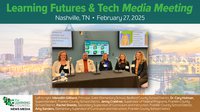In a world where technology drives progress, early adoption in K-12 education is not just about staying ahead—it’s about democratizing access to knowledge and opportunities for all students, particularly those in underserved communities. By embracing cutting-edge technologies, schools can empower students and bridge educational divides, creating a more equitable future.
Pioneering Education Through Technology
The early adoption of advanced technologies in K-12 education transforms classrooms into hubs of innovation. From AI and cybersecurity to quantum computing, these tools are not mere additions—they are essential elements that prepare students for a future defined by rapid technological change. Introducing students to these disciplines early on equips them with the skills needed to thrive in a global economy, breaking down barriers to knowledge and opportunity. In fact, the U.S. Bureau of Labor Statistics projects that employment in computer and information technology occupations will grow 15% from 2021 to 2031, much faster than the average for all occupations.
Democratizing Access and Empowerment
Technology holds the power to democratize education, making high-quality learning accessible to all, regardless of geographic or economic barriers. In underserved communities, where resources are often limited, the strategic implementation of technology can revolutionize education. However, the challenges of last-mile connectivity and internet access remain significant hurdles. Addressing these challenges is crucial to ensuring that students in remote and economically disadvantaged areas can fully participate in the digital revolution. In regions where traditional internet infrastructure is lacking, mobile connectivity offers a creative and cost-effective solution for educational attainment. Mobile technology is often more accessible and affordable than broadband connections, making it a vital tool for reaching students in resource-constrained environments. By leveraging mobile networks, schools and educators can deliver digital content, facilitate communication, and provide real-time access to educational resources. Globally, there are over 6.6 billion smartphone subscriptions, highlighting the widespread availability of mobile technology.
Harnessing Mobile Connectivity for Education
Mobile phones, often the most ubiquitous technology in underserved areas, can be harnessed in innovative ways to enhance learning:
● SMS-Based Learning: In areas with limited internet access, SMS (Short Message Service) can deliver bite-sized lessons, quizzes, and educational content directly to students’ phones. This method is highly cost-effective and can reach a wide audience without requiring smartphones or high-speed internet.
● Mobile Learning Apps: Educational apps that require minimal data usage can provide interactive learning experiences, from language acquisition to mathematics and science. These apps can be pre-installed on low-cost devices or downloaded via local networks, enabling students to learn independently. A study by UNESCO found that mobile learning apps can increase student engagement and improve learning outcomes, particularly in low-resource settings.
● WhatsApp and Messaging Platforms: Platforms like WhatsApp can be utilized for group learning, teacher-student communication, and even distributing educational materials. Teachers can send assignments, provide feedback, and engage students in discussions, all through a platform many students use daily. WhatsApp is used by over 2 billion people worldwide, making it a readily available communication tool for many students.
● Podcasts and Audio Lessons: Educational podcasts and audio lessons can be powerful tools for students with limited access to screens or internet data. These resources can be downloaded and accessed offline, allowing students to learn on the go or in environments where traditional learning tools are unavailable.
● Mobile-Based Assessments: Assessments and quizzes can be conducted via mobile phones, allowing teachers to track student progress in real time. This approach ensures that education remains interactive and adaptive, even in remote or under-resourced areas.
Technology as a Vehicle for Social Mobility
Beyond education, technology serves as a powerful means to harness the energies of youth and uplift communities from poverty. By providing access to digital skills and resources, technology enables young people to create opportunities for themselves and their communities. In areas where economic prospects are limited, digital literacy can open doors to new careers, entrepreneurship, and global markets, driving social and economic mobility. Inflectra’s "Codo-a-Codo" initiative is a prime example of this potential in action. Through this program, Inflectra is bringing software literacy to underprivileged youths in Argentina, equipping them with the skills needed to thrive in the technology sector. By teaching coding and software development, "Codo-a-Codo" empowers young people to break free from the constraints of poverty, opening up new career opportunities and fostering economic growth in their communities. Studies have shown that individuals with digital skills are more likely to find employment and earn higher wages, highlighting the potential of technology to drive economic empowerment.
Overcoming Barriers in Underserved Communities
In many underserved communities, schools face significant barriers in adopting new technologies. Infrastructure challenges, such as unreliable electricity and limited internet connectivity, often impede progress. To overcome these obstacles, a multifaceted approach is required:
● Solar-Powered Classrooms: Implementing solar-powered systems can provide a reliable energy source for schools, ensuring students can access digital learning tools even in areas with frequent power outages. According to the World Bank, approx. 750 million people worldwide lack access to electricity, making solar power a crucial solution for enabling technology adoption in many underserved communities.
● Offline Learning Solutions: In areas where internet connectivity is sporadic or non-existent, offline digital content can be a game-changer. Pre-loaded educational materials on tablets or USB drives allow students to engage with digital learning without the need for constant online access.
● Teacher Training and Support: Teachers in underserved communities often lack the training and resources to effectively integrate technology into their classrooms. Providing ongoing professional development and creating networks for teacher support are essential for ensuring that technology adoption translates into meaningful educational outcomes. Research suggests that effective teacher professional development can significantly improve student achievement.
● Localized Content: Developing educational content that is culturally relevant and available in local languages is crucial for engaging students and making technology a truly transformative tool. Educators can maximize the impact of digital learning by tailoring content to the specific needs and contexts of students in underserved communities.
The Role of Technology Transfer
Technology transfer is crucial in fostering educational equity. By sharing resources, expertise, and digital tools, partnerships between schools, governments, and private organizations can support the growth of educational infrastructures in underserved regions. This collaborative approach ensures that students everywhere have access to the technologies that will define their futures, creating a more inclusive and connected society.
Educators as Catalysts of Change
Educators play a pivotal role in this transformation. They can drive meaningful change by embracing early adoption and integrating these tools into their teaching. Schools must support this by providing ongoing training and resources, allowing teachers to explore and implement new technologies effectively. This enhances the learning experience and ensures that education evolves alongside technological advancements.
Conclusion
The early adoption of cutting-edge technologies in K-12 education is a powerful tool for democratizing knowledge, fostering equity, and uplifting communities from poverty. By addressing the challenges of last-mile connectivity, ensuring access to the internet, and facilitating technology transfer to underserved communities, we can create a world where every student, regardless of their background, has the opportunity to succeed. Initiatives like Inflectra’s "Codo-a-Codo" are paving the way, showing how targeted efforts can bring software literacy and economic opportunity to underprivileged youths. By creatively overcoming resource constraints and focusing on localized, sustainable solutions—especially through mobile connectivity—technology can be a transformative force in even the most challenging environments. This strategic approach will prepare students for a rapidly changing world and harness the potential of young energies to build a more inclusive, empowered, and prosperous society.
About the Author
Adam Sandman founded Inflectra in 2006 and has been programming since he was 10. Now serving as the company's CEO, Adam is responsible for product strategy, technology innovation, and strategic business development. Driven by a deep passion for education, he is dedicated to empowering teachers, students, and communities worldwide to gain a foothold in the technology economy through the Global Technology Initiative.











